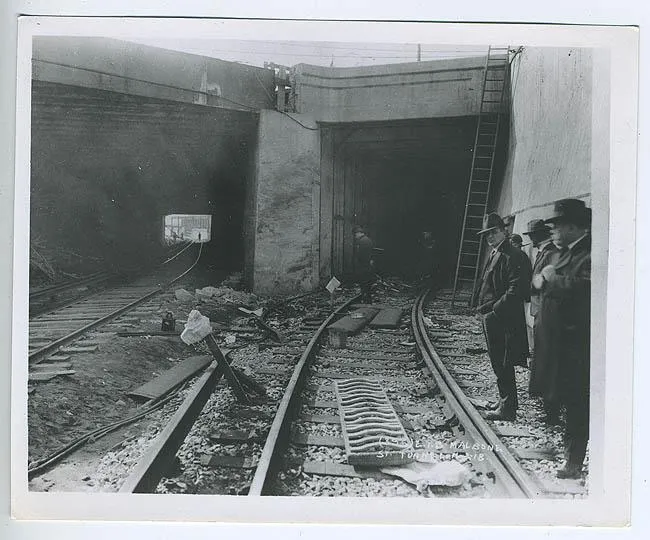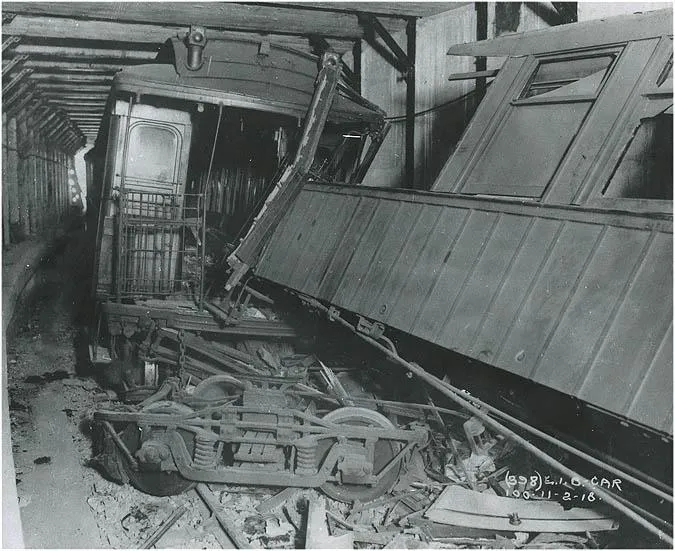The Malbone Street Wreck of 1918
A confluence of circumstances led to the deadly disaster, 100 years ago today, in the New York subway that killed 93
/https://tf-cmsv2-smithsonianmag-media.s3.amazonaws.com/filer/f8/82/f8826072-4be8-4e74-914d-ada6189037aa/img_114322.jpg)
Something was wrong. The Brighton-Beach-bound train was flying through the tunnel under Brooklyn’s Malbone Street way too fast. Its five cars were packed, crowded to the doors with the approximately 650 passengers on board. The driver, inexperienced, put all of those lives in danger. When the wreckage was cleared, and the damage assessed, at least 93 people were dead.
It has been 100 years since the Malbone Street wreck of November 1, 1918, and, despite the dilapidated state of the New York City transit system today, things have indeed improved since then. The cars are no longer wooden and the Brooklyn Rapid Transit Company, which failed to enact multiple safeguards that could have prevented the disaster, has long since ceased to exist. In his 1999 book, The Malbone Street Wreck, historian Brian Cudahy calls the accident "the worst mistake in the history of American urban transportation, ” and it still stands as the deadliest rail accident in New York City's history and one of the deadliest railway accidents in American history.
The dead included a steamship company clerk, an assistant principal, and an engineer whose son, a naval aviator, was on his way to France to fight.
"Had you been aboard that train, most likely you would have been someone who was working in Manhattan or downtown Brooklyn," says Katherine Reeves, the senior museum educator at the New York Transit Museum. "This was a rush hour train--the crash happened at 6:42pm--so you’d be making your way home. The Brighton Beach Line train started at Park Row in Manhattan, then crossed over the Brooklyn Bridge heading to Brighton Beach."
You would have paid five cents to ride in 1918, and the train is today's Franklin Ave Shuttle, says Reeves. (The Brighton Beach Line opened in 1878, and in those days, there were multiple companies; a unified transit company wouldn’t exist until the middle of the 20th century.) The shuttle runs in an open cut--just lower than street level--but not in a tunnel. The wreck occurred at the overpass of what was then Malbone Street. Today, it is Empire Blvd, renamed because of the accident. (There is still a Malbone Street, but it is a nearby dead-end street.) The train rode under the street, then met today's Q line at the Prospect Park Station in Brooklyn, she says.
As the train roared around the curve before Malbone Street, the second and third cars careened into the tunnel’s steel and concrete walls, their sides peeling away. The impact "made matchwood of their sides and roofs and that made indescribable fragments of scores of human beings," reported the Brooklyn Daily Eagle. Sharp wood and metal came up through the bottom of the cars, killing others; one man was impaled on an iron bar that "shot up into the air like a javelin," as a reporter wrote.
One survivor staggered out of the tunnel with his coat and pants torn away, having lost a shoe as well, wrote a New York Times reporter. His lacerated faced bled, and his left arm hung uselessly. His hat, collar, and tie were gone. People parted for him to walk, before he was packed into an ambulance. Those who couldn't move lay on the concrete emergency walk at the tunnel's sides. Those who could, ran. Not because of panic, an Eagle reporter wrote, but from "horror—horror so dreadful that they could not stand the spectacle."
Firefighters lowered themselves down to track level with ladders and forced through the wreckage like "beavers," a reporter wrote, moving through wood and metal to reach the wounded. Volunteers from the Women's Motor Corps drove survivors to the hospital and bodies to the morgue. Others comforted the dying at the scene.

At a Brooklyn morgue the next day, 83 bodies lay covered in single rows along the walls. Frantic onlookers exposed the cadavers, searching for those they knew. Because some bodies were so disfigured, and the force of the crash had ripped off identifying clothes or jewelry from others, identification progressed slowly. Reports described a woman looking into the morgue, crying out, and running away. Another fainted, and then began to pray when she saw her son's body. "I'd rather be any place on earth than here," said one of the officers on duty.
Survivor Margaret Brennan, 16 years old, had been in the fourth car, the Eagle reported. She was in the hospital with two broken legs and a fractured skull. Vera Murphy, a yeowoman in the Navy, was badly injured too. She had been riding the subway with her sister Grace, an assistant principal, who did not survive the crash.
According to Reeves, many factors contributed to the wreck. The train operator, Edward Luciano, had been trained as a dispatcher, but because of a motormen's strike, was tasked with driving the train himself. Before the crash, Luciano had only undergone two hours of direction and taken one shift. Just days prior, his 3-year-old daughter had died of the Spanish flu, the epidemic ravaging the nation, and he too had been struck earlier with the illness.
The switchmen were on strike, too, so it was likely another poorly trained substitute who had coupled the cars together. Typically, the train lineup went like this: regulation motor car (a heavyweight car with motors below it) and then the trailer car (a lightweight car with only wheels below), motor car, trailer car, motor car, Reeves explains. But the train that day was lined up this way: motorcar, trailer car, trailer car, motor car, motor car, meaning that when the first car derailed, those two lightweight trailer cars derailed and slammed into the walls, expelling passengers. The fourth and fifth cars, then, upon collision in the tunnel, ran over those who had survived the initial impact.
After the wreck, the city tried six men in total for manslaughter, says Reeves: Luciano, the superintendent of the BRT’s southern division, the president and vice president of the BRT, the chief engineer of the Brighton Line, and the president of the New York Consolidated Railroad, which was a BRT subsidiary. None were found guilty.
"The defense focused not on human error or bad design of the tracks, but rather on the train having mechanical errors," says Reeves. "Although that doesn’t seem to have been the actual case, even according to the BRT’s own investigation. But that wasn’t talked about in the trial... the prosecution didn’t even question the defense’s talk of mechanical error.”
In its coverage of the trial, the press focused on emotional details of the trials, including Luciano’s young daughter crying, “Papa,” and a partially-paralyzed dressmaker making her way from wheelchair to witness stand. An outraged public wanted someone to blame for the horrific disaster. Adds Reeves, “When the prosecution couldn’t make a case it must have felt frustrating to those who had lost loved ones and those who heard of the story. It’s a tragedy all around, from all sides."

"There never was a really independent investigation," says Mark Aldrich, author of Death Rode the Rails: American Railroad Accidents and Safety, 1828–1965. "There were a couple of court hearings, a grand jurying panel, but what you don't see what you would see today. The NTSB [National Transportation Safety Board] would arrive on the scene and they would pick it apart."
Despite the lack of criminal convictions, the aftermath of the crash "tightened up the existing procedures and sped up the modernization and safety precautions of the transit network" in New York, according to Reeves. "There had already been a start to creating a better signal system, which is basically how today when we have red lights in the subway a stop arm comes up from the tracks, so that if a train passes a red signal ithe stop arm triggers a switch at the bottom of the train and will stop the train," she says.
"After Malbone, the installation of this was sped up. I’ve also been told by former coworkers that third rails used to only be covered in stations. After Malbone, third rails were covered throughout the entire system. Finally, it became much stricter about how many hours of training and what sort of training operators had to have before being allowed to operate trains. "
Luciano's inexperience, speed, and wood. Like the subway itself, the series of things that caused the Malbone Street wreck were forced together at the wrong time, with violent and tragic results.
New York City Mayor John Hylan stood by Helen Hartley's hospital bed, and asked her about the moments before the crash. "To my mind," she told him, "we were going about 100 miles an hour. We all knew the end was coming."